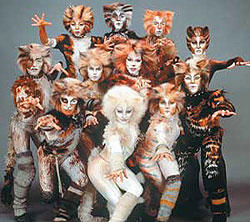Clippard Valves Help Make Magic in Two Broadway Hits
Application Story Published by Clippard, July, 1983
 The musical “Cats” is a smash hit on Broadway, actually sold out eight months in advance. Five million dollars in scenery and special effects are invested in the performances at the Wintergarden Theatre in New York.
The musical “Cats” is a smash hit on Broadway, actually sold out eight months in advance. Five million dollars in scenery and special effects are invested in the performances at the Wintergarden Theatre in New York.
In one of the most exciting moments, “Gus”, a shriveled old theatre cat, becomes transformed into “Growltiger”, the virile cat. Clippard components are key to the magical transformation.
After a year of success, the haunting drama, “Agnes of God”, is making plans of augmenting its Broadway company with national performances. Elizabeth Ashley, Geraldine Page and Amanda Plummer have starred in the play.
The lead in “Agnes” is a nun, who, in the midst of her trauma, suddenly is subject to a stigmata—her hands begin to bleed. This intense and remarkable effect utilizes Clippard components.
Responsible for these spectacular theatrical effects is Richard Huggins and his “Theatre Magic” company of Columbus, Ohio. His purpose is to create high-tech cinematic solutions to theatre problems—and has done just that.
Huggins provides theatrical effects for 70 to 80 different theatre companies each week, throughout the world, from block-buster musicals on Broadway to Las Vegas spectaculars to local amateur groups.
According to Bruce Becknell of The Isaacs Company, Clippard distributor in center Ohio, Huggins phoned about two years ago to price some pneumatic components. His insatiable desire for information led to a visit of the Isaacs facility.
After roaming through the inventory, he became fascinated especially with Clippard products because of their miniature size, a key factor in his theatrical effects.
“Clippard components have the three features that are vital to my operation,” Huggins points out. “They are miniaturization, quality, and dependability. In both of the Broadway hits, my systems are located on the stars. And, just like with the performers, the show must go on. The special effects must work perfectly, time after time after time.”
Key components in both of the systems are Clippard EV-3 electronic/pneumatic interface valves. These Normally-Closed, three-way valves are opened by a six volt signal from a miniature receiver which is triggered by a radio transmission from a remote transmitter.
In the “Cats” application, the complete system on the performer weights only 2.5 pounds including propellant.
The original prototype utilized an EV valve with #10-32 porting to flow Freon liquid into evacuated bladders that formed the upper arm and shoulder area of the cat costume. The Freon vaporized on reaching body temperature.
The bladders were inflated in 12 seconds, transforming the skinny body of the old cat “Gus” into the muscular “Growltiger”. Much to his dismay, Huggins was informed that the process was too slow.
He met the challenge by utilizing the EV as a pilot to trigger a Clippard MJV-2 Normally-Closed 2-way poppet valve equipped with a Clippard MPA-3 pilot actuator. Since the MJV-2 has 1/8” poring, the flow of Freon was greatly accelerated.
Much to the amazement of the sow producer, Huggins was able miraculously to achieve the transformation in just two seconds.
In “Agnes of God”, two EV-3 valves are used to control flow of Freon from a 4 cubic inch volume chamber into tow containers of artificial blood. A Clippard MNV-1KP needle valve on the chamber regulates the amount of flow.
When the interface valves open on radio signal, the Freon is allowed to flow into the blood containers, propelling the red liquid up though the needle valves, fittings, and tubing down each arm, and onto the palm of each hand.
The purpose of using two parallel systems, although there is only one Freon supply, is to achieve backup safety. Should either system fail for any reason, the alternate feeds both arms, and the show goes. On. There has never been a failure du to the operation of the Clippard components.
Automatic cueing by the radio signal is necessary, rather than having the performer do the switching, because dramatically she is in a psychic trance. According to Huggins, players become so preoccupied by their performance that they cannot be relied upon to cue any apparatus.
It is obvious that the creator of “Theatre Magic” possesses a rare genius that combines a sensitive understanding of theatre aesthetics with a remarkable engineering capability.
“What we can achieve in theatre effects is only limited by our imagination,” Huggins emphasizes. “Give us a little time, and we’ll blow their socks off!”





